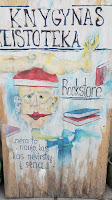Maybe Christmas, the Grinch thought, doesn't come from a store. -Dr. Seuss
 |
| OLD GLOBE PLAZA |
The Grinch endures for children and the “young at heart” in San Diego. This is the twenty-first consecutive year that Dr. Seuss's How the Grinch Stole Christmas! has been featured at the Old Globe Theater in Balboa Park. In the production, the Grinch's heart grows three times bigger, and I like to believe that everyone who attends this play departs with a bigger heart as well.
I had been looking forward to sharing this San Diego holiday tradition with my granddaughter, Mila, for some time now, and finally decided that this was the year—she's four and one-half. When I told her about it, she was excited and it lead to many conversations about how and why this Grinch would steal Christmas. I was glad we were finally on our way to find out what really happened.
 |
| MILA |
We chose an 11 a.m. performance on a Saturday in November. Mila and I meandered along El Prado to the Old Globe, enjoying the sunshine and other visitors who were starting to gather for another pleasant Saturday in the park. Mila had meticulously chosen her favorite dress and brown boots for the occasion.
Today you are you! That is truer than true!
There is no one alive who is you-er than you!
-Dr. Seuss
There is no one alive who is you-er than you!
-Dr. Seuss
The first thing we noticed when arriving at the theater was the white Christmas tree that towers over the plaza entrance during the holidays. It's decorated with banners that say “Merry” and pink candelabras that light up after dark. The tree is always a popular backdrop for photos, however, Mila did not care to have her photo taken today. The next thing she noticed was the snack bar; we sat down at one of the nearby tables and enjoyed a cookie and the many other snacks that her mother had sent along.
 |
| OLD GLOBE THEATER SAN DIEGO |
Plays at the Old Globe are always extremely well done with top quality performers, and this was no exception. Mila loved it and so did I. She might have been a bit frightened of the Grinch at times, but wouldn't admit it. I knew she was having a good time when she started singing along with the audience during one of the songs.
We sat up in the front which made it all the more exciting. The front row seats, off to the side, are priced in the least expensive ticket category, which is another reason I like to go to the Old Globe. It was a 90-minute performance with no intermission.
San Diego has a special connection to Dr. Theodore Seuss Geisel (pen named: Dr. Seuss)–he was a long-time resident of LaJolla, a section of San Diego, where he lived from 1948 until his death in 1991. Audrey Geisel, his second wife, continues to carry on with his love of the arts, education, and literacy through numerous foundations and projects.
Performances of Dr. Seuss's How the Grinch Stole Christmas! will continue through December 29, 2018. Tickets can be ordered by phone (619-234-5623) or online (TheOldGlobe.org.)
Sometimes you will never know the value of a moment until it
becomes a memory. -Dr. Seuss



















































